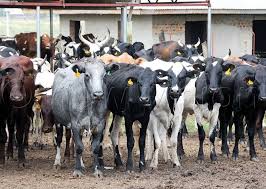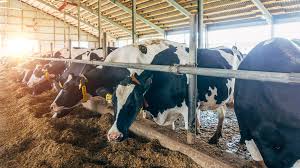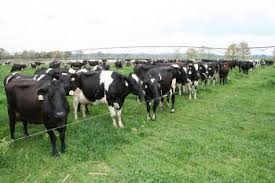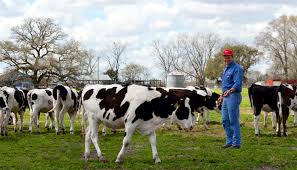Cattle farming practices play a crucial role in the global agricultural landscape, providing essential resources such as beef, milk, leather, and other by-products. This sector not only contributes significantly to the economy but also supports the livelihoods of millions of farmers worldwide.
Cattle farming encompasses a variety of methods, tailored to different environmental conditions, cultural practices, and market demands.
Historically, cattle farming has evolved from traditional grazing methods to more advanced techniques that incorporate technology and modern farming practices. In many regions, cattle are raised primarily for beef production, while in others, dairy farming takes precedence.
Regardless of the focus, successful cattle farming relies on understanding the animal’s needs, managing their environment, and employing sustainable practices to ensure both animal welfare and environmental health.
One of the fundamental aspects of cattle farming is breed selection. Different breeds have unique characteristics that influence growth rates, milk production, and adaptability to various climates. For instance, Angus and Hereford cattle are well-regarded for their beef quality, while Holstein and Jersey breeds are popular choices for dairy production. Farmers must consider local conditions, market preferences, and breeding goals when selecting the appropriate breed for their operations.
Feeding practices are another critical component of cattle farming. Cattle require a balanced diet to grow and produce efficiently. In extensive grazing systems, cattle are often allowed to roam on pastures, consuming grass and forage.
However, in intensive farming systems, supplemental feed, such as grains and protein sources, may be provided to enhance growth rates and milk production. Nutritional management is vital, as it directly impacts the health and productivity of the cattle.
Health management is equally important in cattle farming. Regular veterinary care, vaccinations, and disease prevention strategies are essential to maintain herd health and minimize losses. Farmers must stay informed about common cattle diseases and implement biosecurity measures to protect their herds from potential outbreaks.
Good management practices not only ensure the well-being of the animals but also contribute to the quality and safety of the products produced.
Environmental considerations are increasingly becoming a focus in cattle farming. Sustainable practices, such as rotational grazing and proper waste management, help minimize the environmental impact of cattle farming.
Additionally, farmers are encouraged to adopt strategies that promote biodiversity and soil health, ensuring the long-term viability of their operations. As consumer preferences shift towards more sustainable and ethically produced food, cattle farmers must adapt to meet these demands.
Benefits of Cattle Farming

Cattle farming offers various advantages, both economic and environmental:
1. Source of Income: Cattle farming provides a reliable income through the sale of milk, meat, and other products like leather.
2. Food Security: Cattle produce milk and meat, both essential sources of protein, contributing to local and global food supplies.
3. Employment Opportunities: Cattle farming creates jobs in breeding, feeding, veterinary services, and more, supporting local economies.
4. Soil Fertility: Manure from cattle serves as a natural fertilizer, enriching soil and reducing the need for chemical fertilizers.
5. Sustainable Land Use: Cattle can graze on lands unsuitable for crop production, making use of areas that might otherwise go unused.
Types of Cattle Breeds
Cattle breeds are typically categorized based on their primary purpose. Here are some common types:
1. Dairy Breeds: These breeds are raised for milk production. Examples include Holstein, Jersey, and Guernsey. They produce high-quality milk with varying levels of butterfat.
2. Beef Breeds: Beef breeds are raised primarily for meat. Examples include Angus, Hereford, and Charolais. They grow quickly and provide high-quality beef.
3. Dual-Purpose Breeds: These breeds are valued for both milk and meat production. Examples include Simmental and Shorthorn. They offer moderate milk production and good meat quality.
4. Draught Breeds: Draught breeds are used for labor, such as plowing fields and transporting goods. Examples include Oxen and Brahman. These breeds are hardy and strong, suitable for physical tasks.
Selecting the Right Cattle Breed
Choosing the right breed depends on various factors, including your goals and environmental conditions:
1. Purpose of Farming: Determine if you want cattle for milk, meat, or both. For dairy production, consider breeds like Holstein or Jersey. For meat, breeds like Angus or Hereford are ideal.
2. Climate Adaptability: Select breeds suited to your climate. For example, Brahman cattle are heat-tolerant and suitable for warmer regions, while Hereford cattle are more resilient in cooler climates.
3. Feed Availability: Choose breeds based on available feed resources. High-yielding breeds like Holstein require more feed, while hardy breeds like Jersey can thrive on less.
4. Disease Resistance: Some breeds have better resistance to diseases common in certain areas. Brahman cattle, for instance, are more resistant to ticks and tropical diseases.
5. Space and Facilities: Consider the space and facilities available. Larger breeds require more space and stronger structures, while smaller breeds may be more manageable on limited land.
Cattle Housing and Shelter
Providing proper housing and shelter for cattle is essential to protect them from extreme weather and ensure their overall well-being. Here’s what to consider:
1. Shelter Design: Cattle shelters should have a roof to protect animals from rain, sun, and wind, with enough open space for ventilation.
2. Space Requirements: Each animal should have sufficient space to lie down, move, and feed comfortably. Dairy cattle need around 40-50 square feet, while beef cattle may require 30-40 square feet.
3. Bedding Material: Use bedding like straw, sand, or wood shavings to keep cattle comfortable and dry. Clean and replace bedding regularly to prevent infections.
4. Drainage System: Ensure proper drainage to avoid water accumulation. Standing water can cause hoof diseases and increase the risk of bacterial infections.
Read Also: 15 Medicinal Health Benefits of Ficus Deltoidea (Misletoea Fig)
Nutrition and Feeding Practices

Proper nutrition is vital for cattle health, growth, and productivity. Here’s how to provide balanced nutrition:
1. Forage: The primary component of a cattle diet is forage, such as grass, hay, and silage. Forage provides fiber essential for digestion.
2. Grains and Concentrates: For increased energy, especially for lactating or growing cattle, add grains like corn and barley. Balance with forage to avoid digestive issues.
3. Protein Supplements: Protein is important for growth and milk production. Sources include soybean meal, alfalfa, and cottonseed.
4. Mineral and Vitamin Supplements: Offer mineral blocks or supplements, such as calcium, phosphorus, and vitamins A, D, and E. These support bone health, immunity, and reproduction.
5. Feeding Schedule: Feed cattle at regular intervals, typically twice a day. This helps maintain their digestive system and prevents overeating.
Water Requirements for Cattle
Cattle need constant access to clean, fresh water. Here are some guidelines for meeting their hydration needs:
1. Daily Water Intake: On average, cattle require 10-20 gallons of water per day, with higher needs in hot weather or during lactation.
2. Clean Water Source: Ensure water sources are clean and free from contaminants. Automatic waterers or large water troughs are ideal for accessibility.
3. Temperature Management: In colder climates, consider heated waterers to prevent freezing. In hot climates, shaded water areas help keep water cool and palatable.
4. Placement of Water Troughs: Place water troughs in easily accessible locations to encourage regular drinking and minimize competition among animals.
Health Management and Disease Prevention
Proactive health management is essential for preventing disease and ensuring cattle well-being. Here’s a basic approach:
1. Regular Veterinary Check-Ups: Schedule routine health assessments with a veterinarian to detect and treat any early signs of illness.
2. Vaccinations: Protect cattle against common diseases like brucellosis, foot-and-mouth disease, and BVD (Bovine Viral Diarrhea) with appropriate vaccines.
3. Parasite Control: Implement a parasite management program that includes deworming and monitoring for external parasites like ticks and flies.
4. Hoof Care: Trim hooves regularly to prevent lameness and hoof diseases. Also, ensure the ground in housing areas is free from sharp objects.
5. Biosecurity Measures: Limit the introduction of new animals and visitors to reduce disease spread. Use quarantine areas for any new or sick animals.
Breeding and Reproduction in Cattle
Effective breeding and reproduction practices are key to a successful cattle operation. Here are essential aspects to consider:
1. Selecting Breeding Stock: Choose cattle with desirable traits such as high milk production, disease resistance, and good temperament to improve the overall quality of the herd.
2. Breeding Methods: The two main methods are natural breeding and artificial insemination (AI). AI allows for controlled breeding and access to high-quality genetics without requiring a bull on-site.
3. Estrous Cycle Management: Cows have an estrous cycle of approximately 21 days. Monitoring for signs of heat helps with timely breeding and increases conception rates.
4. Pregnancy and Calving: The gestation period for cattle is around 9 months. Provide pregnant cows with a balanced diet and monitor them closely as calving approaches.
Read Also: 5 Medicinal Health Benefits of Scutellaria nana (Dwarf Skullcap)
Grazing Management Techniques

Proper grazing management maximizes pasture utilization and promotes cattle health. Consider these strategies:
1. Rotational Grazing: Divide pastures into smaller sections and rotate cattle among them to allow grass time to regrow. This enhances pasture productivity and prevents overgrazing.
2. Intensive Grazing: With intensive grazing, cattle graze a small area for a short period, then move to a new section. This technique can increase forage intake and improve soil health.
3. Strip Grazing: Use movable electric fences to control cattle access to strips of pasture, allowing precise control over grazing and reducing waste.
4. Stocking Density: Adjust the number of cattle per acre based on pasture quality and forage availability. Overstocking leads to overgrazing, while understocking can result in wasted forage.
Record Keeping in Cattle Farming
Maintaining accurate records helps monitor herd health, productivity, and profitability. Key records to keep include:
1. Animal Identification: Assign each animal a unique ID (e.g., ear tags) for easy tracking of health, breeding, and production records.
2. Health Records: Document vaccinations, deworming, and treatments. Tracking health history helps identify recurring issues and plan preventive care.
3. Breeding and Reproduction Records: Keep track of estrous cycles, AI or breeding dates, pregnancy checks, and calving dates for each animal to optimize reproductive performance.
4. Financial Records: Track expenses, income, and overall farm profitability. This helps assess the economic viability of the operation and identify areas for cost savings.
Sustainable Practices in Cattle Farming
Adopting sustainable practices enhances environmental health and promotes long-term farm viability. Consider the following:
1. Manure Management: Compost manure for use as a natural fertilizer, reducing the need for chemical inputs and improving soil health.
2. Soil Conservation: Use cover crops and buffer strips to prevent soil erosion and maintain soil fertility. Healthy soil leads to better forage and crop production.
3. Water Conservation: Implement rainwater harvesting systems and use efficient watering techniques to reduce water waste and protect local water sources.
4. Biodiversity Conservation: Plant native trees and shrubs around pastures to create habitats for wildlife, improve soil structure, and enhance the ecosystem around the farm.
Do you have any questions, suggestions, or contributions? If so, please feel free to use the comment box below to share your thoughts. We also encourage you to kindly share this information with others who might benefit from it. Since we can’t reach everyone at once, we truly appreciate your help in spreading the word. Thank you so much for your support and for sharing!
Read Also: Six Health Benefits of Sugarcane Juice

